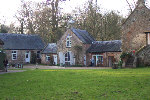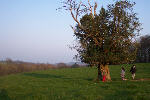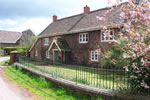Broomfield is a beautiful place to wander and, as you walk the quiet lanes, you experience a timeless quality whilst the village itself evokes images of a past age. Collinson, the Somerset historian, writing at the end of the eighteenth century, described Broomfield thus:
"It is beautifully varied, with swelling hills and deep romantic vales, and commanding a great variety of pleasing landscapes and very extensive prospects. This parish has always been remarkably healthy, even in times of general sickness elsewhere"
I cannot comment on the health of the current inhabitants, but the rest of the description remains true today.
Broomfield was once famous for its annual fair held on All Saints day 1st November. For more than 600 years a Fair was held on the village green and in the Fair Field opposite, people came from miles around to sample of its delights. Sometime during the 1890s it ceased to be held, about the time that Fyne Court burnt down.
Although this has always been a parish of isolated farms and lonely cottages scattered over 4 000 acres, the village has declined in size over the last 100 years. In the census for 1861 its population was recorded at over 500 but now only about 190 people live in the parish. During the last century less than 10 houses have been built and, of the earlier dwellings, over 30 now lie in ruins hidden by a tangle of brambles and ivy or have completely disappeared, their stone being used to mend existing buildings or farm roads. The church provides a centre for the village and only a few houses remain.
The school was closed in 1933 and is now the village hall:
"The hall was built in 1854 and was initially the village school and teacher's house. During the 1950s the building was bought for the village and the school became the village hall as we know it today.
The hall is held in trust and run by members of the community for use by local villagers and others who wish to enjoy the tranquillity, which the hall enjoys."
( Broomfield Village Hall Management Committee brochure.)
When excavations were carried out in the field behind the old school building there was found traces of mediaeval buildings as well as more modern ones. It is known that there was a church house, which was at the West End of the churchyard, but this too no longer exists and the almshouses, which were situated near Staddon's Farm, have also disappeared. There was a post office from 1859 but this was closed in 1994, during its existence the post office was housed in 3 different locations within the village. The postman, until the coming of the car, had to delegate his round so as to make sure the mail was delivered in time as the parish was so spread out.
Some of the farms are of great age, such as Ivyton, Oggshole, Lydeard and Rooks Castle, while the small smallholdings have been amalgamated, and yet the field names remain now to tell their story. Greenway, where an ancient trackway ran, Kings hill and Priors Down, which were once owned by King John who gave them to Taunton Priory in 1204. Other field names suggest a time when Archery Practise had to be done 'Butts Close'. The village has a great history.
Fyne Court
Once owned by the Crosse family, Fyne Court is now home to the Somerset Wildlife Trust, being leased from the National Trust. In 1894 the main hall burnt down leaving the buildings you can see today. The extensive grounds are open to the public (free entrance) and there are several walks, including an easy access route suitable for wheelchair users.
The grounds were landscaped by the Crosse family but have in the main returned to nature and provide a wide variety of habitats which include meadows, woodlands and ponds. There are remnants of an arboretum created originally in 1780 in front of the buildings, which can be seen as you wander round the woodland. It is a site particularly noted for its fungi, there have been more than 100 species recorded, it is also home to rare invertebrates. Within the designed landscape there is featured a complex leat system and several ponds. The largest was created as a boating lake for use of the Crosse family, it is the highest standing water on the Quantocks, but now it has leaks and has become partially silted up. This pond still provides a home for the great crested newt as well as a wide variety of other wildlife.
Wizard created life in Broomfield
Known to locals of the early nineteenth century as Wizard Crosse, whose house was best avoided (especially after dark), Andrew Crosse was an amateur scientist with a particular interest in electricity. In certain weather conditions, such as heavy storms, his equipment would cause the windows of his laboratory to be brilliantly lit up by continual flashes of light, and loud bangs were to be heard emanating from the house! Thus his other title "The Thunder and Lightning Man".
In one experiment, designed to create silicate crystals, he passed electricity through a solution of flint and potassium carbonate, dropped onto a piece of volcanic stone that had been saturated with hydrochloric acid. After two weeks he was shocked to find not crystals, but small mites! When news of this got out he was falsely accused of claiming to have created life and, as a result, had to endure widespread criticism. In December 1837, by request, he submitted details of his experiment to the Electrical Society of London and, in his introduction, made clear his position:
I must state, not for the sake of myself (for I utterly scorn all such misrepresentations), but for the sake of truth and the science which I follow, that I am neither an "atheist", nor a "Materialist", nor a "self imagined creator", but a humble and lowly reverencer of that Great Being, whose laws my accusers seem wholly to have lost sight of. More than this, it is my conviction, that science is only valuable as a means to a greater end. I can assure you, sir, that I attach no particular value to any experiment that I have made, and that my feelings and habits are much more of a retiring than an obtruding character; and I care not I what I have done be entirely overthrown, if truth be elicited.
At Fyne Court Crosse not only conducted many experiments but also entertained other like-minded individuals. His friends included the poet Robert Southey, Lady Ada Lovelace (daughter of Lord Byron), Charles Babbage (the father of computers), Sir Humphrey Davy (inventor of the miners lamp). He was born in Fyne court in 1784 and he died in the same bed in 1855. He was an intelligent and hospitable country squire, who had a great love for his surroundings and community.
Andrew Crosse's son, John, was very friendly with Lady Ada Lovelace. When she died she left him Byron's signet ring and lock of hair, which are still in his family's possession. John also had a portion of Ada's life insurance, in return he agreed to destroy all Ada's letters to him of which there had been over 100. John changed his name from Cross to his mother's maiden name, Hamilton, and a plaque commemorating both John and his wife Susan are to be found in Broomfield's lovely church.
For full details of his experiment: http://www.rexresearch.com/crosse/crosse.htm
More detailed information about his life can be found in the booklet 'Andrew
Crosse, Scientific Squire of Broomfield', available at Fyne Court.
Drink to The Devil
Ruborough is an ancient camp, perhaps iron age, about 1 mile to the North East of the village, that it was quite likely used by the Romans is evidenced by a number of Roman coins that have been unearthed. An interesting feature of this fort was a subterranean tunnel, now filled in, that gave people inside the camp safe access to a nearby spring.
It was also the scene of a strange treasure hunt as the legend goes. About 1780 a Dr Farrer, who lived in the village, heard the story of great treasure buried in Ruborough. He decided to investigate, using a hazel stick as a divining rod he walked all over the site and when he felt it jerk he believed he had found the entrance to the gold. Marking the spot he went to get his servant to help. When the moon was full he and his servant returned to the spot, the good Doctor then made his servant dig and it was not long before the pick hit something hard, maybe the door to the great hoard of gold! Immediately there was a great roar and a hideous chorus of groans and screams rang out and the servant felt himself being grabbed and pulled down by what the man thought were demons straight from hell. The good Doctor grabbed his servant and luckily having his bible with him waved it in one hand whilst managing to pull his servant out of the hole, and they both ran as fast as the could back to Broomfield.
The truth of this tale is not known, but it is an interesting tale and many say that the good Doctor had a little too much of the local brew. You know what strong Somerset cider is like!
St Mary's and All Saints church
The church is an interesting building, the oldest part is the south chancel wall, which had a small priest's doorway now plastered inside, and was built about 1320. The tower was completed around 1440, it is in three stages with angled buttresses, gargoyles perch on the top corners. The tower is similar to the one at Dunster which is known to have been built by a John Maris of Stogursey in 1446 it is very possible that he had a hand in the building of this church tower.
Inside the church, under the matting in the tower, there is a fine brass effigy of a priest in mass vestments with chalice and host which is thought to be the only example in this county. Unfortunately, the head is missing. The inscription reads:
"Richard Dulverton 1443, chaplain, who governed this church in a praiseworthy manner, to the honour of God, the Blessed Mary, and All Saints for twenty-three years. He sumptuously repaired and magnificently decorated it."
There are recorded in the porch details of some of the very interesting charities that exist in the parish. A good example is that:
"honest workmen" may apply for free tools if they have not pawned those given to them in the previous year!
Another interesting piece of furniture in the church is the little table opposite the south door, if you lift up the cloth you will see a band of copper across it. This table came from Fyne court and was once used by the pioneer electrician Andrew Crosse for some of his experiments.
External sites about Broomfield
- Broomfield Parish Web Site
- Broomfield Marriages - 1630 to 1812
westcountrygenaelogy.com - British History Online
Links straight to Broomfield entry. Scroll past the footnotes to find even more information. - Office For National Statistics (ONS) detailed data
Detailed Broomfield parish data - if no data available at parish level links are provided to data at ward and local authority levels. - Office for National Statistics (ONS) summary data
Summary statistics for a slightly larger area around Broomfield. - top of page













